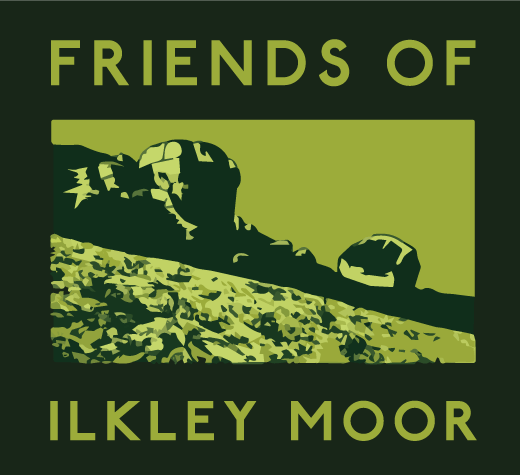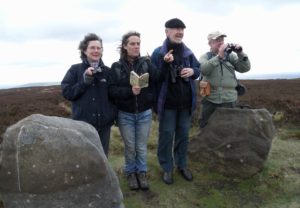Ilkley Moor Breeding Birds Survey
We approached Bradford Ornithological Group (BOG) to request if a survey of the “upper slopes” of Ilkley Moor could be made to establish the bird species that breed there. And we are pleased that BOG was able to oblige. We would like to share their findings.
The boundaries of the survey area covered Crawshaw Moss, East Buck Stones, Whetstone Gate, Ashlar Chair, following the path to Gill Head. From there turning west towards Badger Stone, Grammings Head, Heber Moss, then following the wall above Silver well Cottage and back to Crawshaw Moss.
The following breeding Indicators were used:
- Bird apparently holding territory
- Courtship & display
- Anxiety call/ agitated behaviour indicating presence of young or nest
- Adult visiting probable nest site
- Nest building
- Distraction display or injury feigning (broken wing)
- Used nest found
- Recently fledged young
- Adult carrying faecal sack or food
- Nest with eggs found, or bird sitting but not disturbed or eggshells found
- Nest with young
The survey took place in the months of May and June 2018. If the same species was recorded on both visits, this was also reasonable evidence to assume that breeding was attempted.
BOG mustered seven members to take part in the survey and they made in total 12 visits during May & June.
Here is the summary of their findings:
Meadow Pipits are extremely common and there is a healthy population. The same applies to red grouse which is not surprising as the whole habitat has historically been controlled for the benefit of this species.
This “maintenance” will include the removal of predators such as weasel, stoat and fox controlling the habitat to maximise grouse breeding and in addition probably making the moor unattractive to some raptors.
Both hen harrier and short-eared owl can choose rank heather to nest in so keeping it short is a method of control.
It is difficult to make a decision as to the status of curlew because this bird is soon disturbed and takes off, circles, calls and re-lands only to fly up again. Birds also will visit Ilkley Moor from the other moors making up Rombalds for foraging purposes.
Skylark’s habit of lifting to sing assists the observer and it was noticeable that a healthy number congregated around the highest point on the moor. The habitat is short vegetation created by low bilberry cover which this bird prefers for nest sites.
Recently fledged young golden plovers were recorded and other pairs noted in suitable habitat. Again, this species moves about to feed on Rombalds Moor so actual numbers of breeding birds is difficult to ascertain from this single survey.
On nearby Bingley Moor, a survey has been made of birds in a tetrad and there appears to be little change over the fifteen years recording. One would expect the same for Ilkley Moor.
There are two species which did not fare well and are important breeders on moorland. Although it was good to see records of a pair of redshank by most observers and suspect strongly of breeding, both this species and snipe records were poorly represented. It was particularly disappointing not to record snipe in the Crawshaw Moss area as the habitat looks suitable. However snipe was recorded on two visits with birds heard or seen to the east of the trig point in low lying areas.
On nearby Bingley Moor two species have increased in breeding and numbers; greylag goose and canada goose, so it is not surprising that the two species turned up on Ilkley Moor. Canada goose control does not require a licence and the ones on Bingley Moor have started to reduce in numbers.
After consulting with the observers, a particular problem was noticed by everybody, namely the number of dog walkers, both casual and business (Professional dog walkers), and their lack of adhering to the signs about disturbing breeding birds. But it must be pointed out that Ilkley Moor is used by walkers, joggers and birdwatchers that stay mainly to recognised pathways.
However, the loose dog goes anywhere. The ground is the only place where birds can build their nests on the moor so we should continue to press home the message to keep the dogs on a lead and under control.
FoIM would like to thank Bradford Ornithological Group for providing us with this survey which will greatly add to our knowledge of the ecology of Ilkley Moor.
Participants – Pete Roberts, John Preshaw, Derek Parkin, Mike Bloomfield, Chuck Butler, Keith Allen & Shaun Radcliffe.

